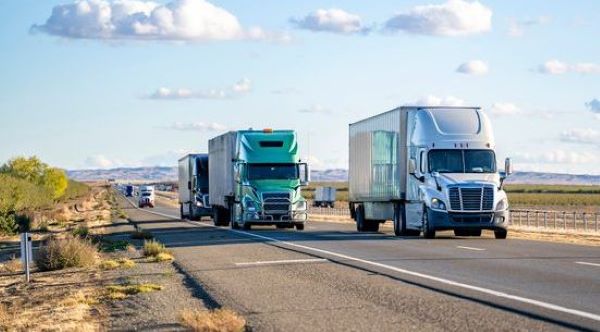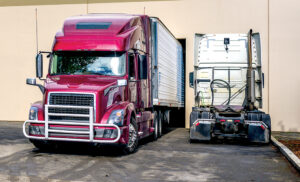It seems that every year brings more innovation to the trucking industry, especially when it comes to safety options.
Advanced driver assistance systems (ADAS) have progressed from dodgy warning devices that alerted drivers to hazards (and sometimes to non-hazards) into systems that can actually control the vehicle. Modern trucks can accelerate, brake and steer vehicles without driver input. They can even override the driver’s actions to help achieve safe results. Onboard cameras and sensors supplement the driver’s eyes, and computers make decisions faster than the driver can.
Remember those old urban legends about RV operators setting the cruise control, then leaving the driver’s seat and heading to the back to make a sandwich? ADAS have actually made this possible — but that doesn’t mean it’s an intelligent choice.
While ADAS has undoubtedly improved highway safety, those systems don’t come into play until a hazard is present. In many cases, the situation the ADAS corrects could have been avoided by the driver taking appropriate action ahead of time.
In a nutshell, there is no substitute for basic, safe driving behavior on the part of a professional driver. The best drivers have numerous safety strategies stored safely in their mental “toolkit.”
Two of those strategies, usually employed in tandem, are speed and space. These are a driver’s best tools to avoid hazardous situations.
Space
The space between your vehicle and the one in front is your biggest protection against a hazard that suddenly develops in front of you. The equation is simple: You either have time to react to whatever that vehicle does — or you don’t.
Maintaining a safe distance — space — gives you that time.
Despite the well-known need for space, take a short trip down virtually any interstate highway and you’ll soon spot a tractor-trailer tailgating another vehicle. Sometimes it’s intentional — the driver may be trying to intimidate the vehicle in front into either going faster or moving over.
More often, however, it’s a matter of complacency, and the truck driver is letting the driver in front do the thinking. Since it would be irrational for the vehicle in front to suddenly stop or lose control, the thinking goes, the trailing vehicle isn’t in danger … until, suddenly, it is.
The reality is that motorists, including truck drivers, make bad decisions all the time. If you’re following too closely, you could end up a victim of a poor decision from the driver you’re behind.
Space is your protection. If you can’t stop, you’re too close.
Some defensive driving programs teach drivers not to get “boxed in,” or to always make sure they have an “escape route” if they can’t stop in time. The safest thinking is that the space in front of your vehicle is your escape. When a hazard suddenly appears in front, there isn’t much time to check mirrors to verify that a lane change can be safely made. Your FIRST reaction must be to brake.
Speed
Speed controls space. Savvy drivers know that driving slightly slower than surrounding traffic helps keep space available in front of the vehicle.
Yes, people are going to pass you, and some of them will move into the space you’re trying to create in front, but since that traffic is already moving faster, the gap will reopen if you let it. Some drivers are under the mistaken impression that they enhance their safety by staying close to the vehicle in front, preventing others from getting into that space. That’s a great recipe for a rear-end collision and an embarrassing conversation with law enforcement.
Every driver knows that speed is cited as a factor in a majority of accidents. While some may use those statistics as a rationale for supporting speed limiters or stricter speed limit enforcement for trucks, the reality is that speed can be a factor even when vehicles are traveling at speeds well under the limit. Traffic, road conditions and other factors play a role, too.
For example, about 18.6% of accidents resulting in death involving large vehicles in 2021 were single-vehicle accidents, according to the FMCSA. That’s nearly one in five where a truck driver was killed in a one vehicle crash. Typically, those are loss of control accidents that often involve leaving the road and/or rolling over, both of which can be caused by driving too fast for conditions.
Space + Speed
Regardless of statistics, one thing is true. No driver ever emerged from a serious accident wishing they had been following more closely or had been traveling faster. Never.
Quickly calculating the correlation between space and speed is a skill taught in any basic driving course, whether the driver will be piloting a passenger vehicle or a commercial truck. It’s important that every driver understands how to measure proper following distance and periodically practice this skill to keep it sharp. Forget methods that advise certain numbers of truck lengths or other distances that require you to estimate the distance.
Using time as a measurement is more accurate. It’s a simple matter of observing when the vehicle ahead passes a fixed object such as a sign, bridge, roadkill — whatever. Then, just count off the seconds until your vehicle reaches the same object.
So, you ask: How many seconds is enough?
Remember, your total stopping distance depends on four factors.
- The first is your perception time — the time it takes you to identify a hazard and make the decision to stop. For most people, that takes a half-second or more (even more if you’re distracted).
- Then comes reaction time — how long it takes to move your foot to the brake pedal and press it. That’s another half-second or more.
- Once you’ve stepped on the brake, something called brake lag occurs. The air lines must pressurize and then activate the mechanism that brings the shoes in contact with brake drums or pads in contact with rotors. That can be another half-second.
- Finally, braking time occurs when the brakes are fully applied until your vehicle comes to a stop. Braking time depends on your speed as well as the mechanical condition of your brakes.
Most safety programs recommend a minimum of five seconds of following distance. More is better. Six seconds allows an extra second, helpful if the driver is distracted looking in a mirror, checking gauges or another activity.
Miles per hour, or mph, can be converted to an estimated feet-per-second by simply multiplying the speed by 1.5. For example, a speed of 60 mph means your truck is covering roughly 90 feet per second. One extra second of following distance means an extra 90 available feet to stop. That can easily be enough to prevent an accident — and even save a life.
Cliff Abbott is an experienced commercial vehicle driver and owner-operator who still holds a CDL in his home state of Alabama. In nearly 40 years in trucking, he’s been an instructor and trainer and has managed safety and recruiting operations for several carriers. Having never lost his love of the road, Cliff has written a book and hundreds of songs and has been writing for The Trucker for more than a decade.















There some companies that are not teach their drivers about the need to keep a safe distance between them and other travelers,
Good luck getting today’s truck driver to follow that idea. The majority are in such a big hurry to get to the nearest ditch or be the first on scene of the latest accident these days.